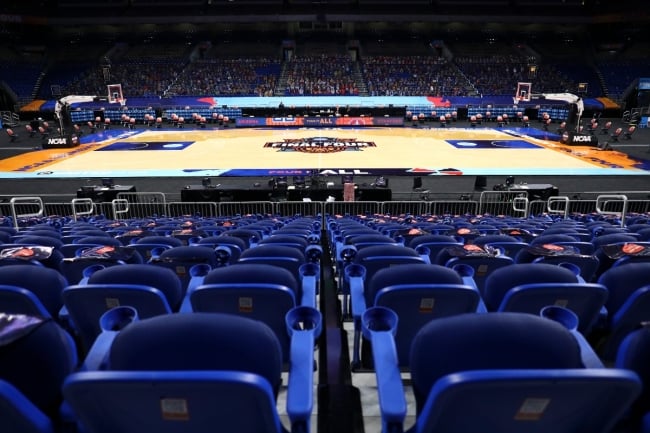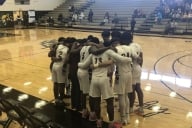You have /5 articles left.
Sign up for a free account or log in.

The new NCAA constitution hopes to address a “huge gap” in Division I sports.
C. Morgan Engel/Getty Images
The National Collegiate Athletic Association offered a glimpse into the future of college athletics Monday, unveiling a proposed new constitution that acknowledges that athletes should be compensated for their images and likenesses and distributes power away from the central office to the group’s three divisions.
Under the draft, released ahead of the NCAA’s special convention next week, each division would have the authority to organize itself, consistent with the principles of the NCAA, and create new divisions or subdivisions. Additionally, divisions could determine governing structure and membership eligibility for new organizations and set standards for academic eligibility and how revenue is shared.
The draft was shared with NCAA schools and conferences ahead of a special Nov. 15 convention, which the NCAA Board of Governors called for in July. Among other notable changes, the new constitution is considerably shorter than the old one—down from 43 pages to 18.5—and shrinks the Board of Governors, which has decision-making authority on all NCAA issues, from 21 members to nine. Additionally, for the first time, the board and each of the divisional leadership bodies will include student athletes as voting members.
"Thanks to the feedback from member schools and conferences, advocacy groups, coaches and students, this process has been an example of how we can work together to modernize college sports and meet the needs of students engaged in intercollegiate athletics—today and for the future," Jack DeGioia, NCAA Board of Governors chair and Georgetown University president, wrote in a memo to NCAA members. "We have reached an important milestone in our efforts. Over the next two months, we will engage in the next phase of our work."
The draft also defines the priorities and principles important to the NCAA, asserting that the organization “embraces” name, image and likeness (NIL) “benefits for student-athletes while prohibiting pay-for-play.” It also reaffirms existing revenue allocations and championship opportunities for each division and "assures" that each division has oversight of its own budget, expenditures and revenue distribution to its member institutions. Furthermore, the draft places new emphasis on diversity, inclusion and gender equity, as well as on student athlete mental health.
The new constitution aims to address a “huge gap” in Division I sports and could possibly lead to a new division, like Division IV, West Virginia University athletics director Shane Lyons told the Associated Press. Lyons, the chairman of the Division I Council and a member of the NCAA’s Constitution Committee, noted that some Division I institutions have athletics budgets of $175 million, while others have just $4 million budgets to work with.
“Once we got into this, we really found out that many of the issues were at the Division I level,” Lyons said.
Amy Perko, CEO of the Knight Commission on Intercollegiate Athletics, an independent group with an educational mission for college sports, said the problem with the NCAA has never been the principles in the organization’s constitution, but rather putting the principles into practice.
“It’s clear that this redraft pushes the really big decisions to Division I leaders to define a future for the association’s highest-profile division,” Perko said. “Division I will have a lot of hard work ahead of them to create its own operating bylaws, make its own academic eligibility rules, decide how to handle revenue distribution and enforcement.”
Perko said there will likely be some changes to the draft as NCAA members provide feedback and approve the final new constitution in January. She noted that the core constitutional principles in the NCAA’s draft constitution are not very different from what they are now.
“The draft of the NCAA constitution, we think, is in the right direction,” Perko said. “But the real work, particularly for Division I, lies in the months and weeks ahead.”
Perko noted that under the draft, Division I would decide how its rules would be enforced, which could change the structure of the NCAA enforcement department as it currently exists. Enforcement staffing could change for each division if it decides to perform its functions differently.
She recommended that Division I leaders use the Knight Commission’s Connecting Athletics Revenues With the Educational Model of College Sports report, which suggests that the revenue-generating entities for Division I spend their revenue more directly on college athlete education, including athlete health, safety and well-being, and gender and racial equity.
The NCAA’s Constitution Committee will provide its final recommendations to the Board of Governors by Dec. 15. Following the January 2022 convention and enactment of the constitution, each division will adopt additional changes to be effective Aug. 1 for the following academic year, with more expected after that date, the NCAA wrote in a press release.
Three student athletes participated in creating the draft. Kendall Spencer, a former track and field athlete from the University of New Mexico, who became the first student athlete representative on the Division I Board of Directors in 2015, told NCAA correspondent Andy Katz in a livestream that the push to add student voices in the constitution began in 2013.
"It's about trust," said Spencer, who recently graduated from Georgetown's law school. "One of the biggest things we've really seen is when you get student athletes in the room, they're going to be prepared. I think now that administrators are starting to see that, it's becoming a process that people are not only trusting a lot more but they're beginning to actually embrace, and that's incredibly powerful. I don't think we would be where we are today without that sort of transformation."
The draft states the board and each of the divisional leadership bodies will include student athletes as voting members.
For Madeleine McKenna, a former volleyball player at California University of Pennsylvania, one of the draft’s most important changes is the inclusion of mental health, which is listed as a priority alongside student athletes’ physical health.
“The current constitution makes no mention of mental health,” McKenna said. “It just talks about affecting the physical well-being of student athletes. And as we’ve seen, that’s not enough.”








